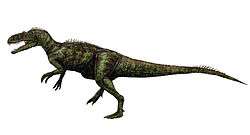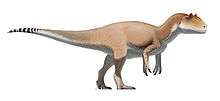Chilantaisaurus
| Chilantaisaurus Temporal range: Late Cretaceous, 92 Ma | |
|---|---|
 | |
| Restoration of C. tashuikouensis | |
| Scientific classification | |
| Kingdom: | Animalia |
| Phylum: | Chordata |
| Class: | Reptilia |
| Clade: | Dinosauria |
| Order: | Saurischia |
| Suborder: | Theropoda |
| Family: | †Neovenatoridae |
| Genus: | †Chilantaisaurus Hu, 1964 |
| Species | |
| |
Chilantaisaurus ("Ch'i-lan-t'ai lizard") is a genus of neovenatorid theropod dinosaur from the late Cretaceous Ulansuhai Formation of China (Turonian stage, about 92 million years ago). The type species, C. tashuikouensis, was described by Hu in 1964. Chilantaisaurus was a large theropod, estimated as weighing between 2.5 metric tons (2.8 short tons)[1] and 4 metric tons (4.4 short tons).[2] In 2010, Brusatte et al. estimated it to weigh 6,000 kilograms (13,000 lb), based on femur length measurements.[3]
It was 11 m (36 ft) [4] to 13 m (43 ft) [5] long.
Classification
Hu considered Chilantaisaurus to be a carnosaur related to Allosaurus,[6] though some subsequent studies suggested that it may be a spinosauroid, possibly a primitive member of the spinosaurid family (Sereno, 1998; Chure, 2000; Rauhut, 2001) because it had large claws on the forelimbs thought to be unique to that group. Other studies suggested that it could be a member of an alternate offshoot of neotetanuran theropods, with some similarities to allosauroids, spinosauroids, and coelurosaurians.[7] A 2009 study noted that it was difficult to rule out the possibility that Chilantaisaurus was the same animal as the carnosaur Shaochilong, which is from the same geological formation. However, they did note an enormous size difference between the two.[8] Further study by Benson, Carrano and Brusatte found that it was not as closely related to Shaochilong as first thought, but that it was a carnosaur (of the family Neovenatoridae), closely related to Allosaurus as Hu had initially thought.[1]
Several species have been described based on very poor remains. "Chilantaisaurus" sibiricus is based on a single distal metatarsal from the Turginskaya Svita of the Buryat Autonomous Soviet Socialist Republic, Russia, dating to the Early Cretaceous (Berriasian-Hauterivian).[9][10] It is poorly described, so its relationships cannot be accurately determined (Chure, 2000) and its placement as a species of Chilantaisaurus is highly questionable. "Chilantaisaurus" maortuensis was reclassified as Shaochilong maortuensis in 2009.[8] "Chilantaisaurus" zheziangensis, based on bones from the foot,[11] is actually a therizinosaur.[12][13]
References
- 1 2 Benson R.B.J.; Carrano M.T; Brusatte S.L. (2010). "A new clade of archaic large-bodied predatory dinosaurs (Theropoda: Allosauroidea) that survived to the latest Mesozoic". Naturwissenschaften. 97 (1): 71–78. Bibcode:2010NW.....97...71B. doi:10.1007/s00114-009-0614-x. PMID 19826771.
- ↑ Paul, G.S. (1988). Predatory Dinosaurs of the World. New York: Simon and Schuster. p. 314.
- ↑ Brusatte, S.L.; Chure, D.J.; Benson, R.B.J.; Xu, X. (2010). "The osteology of Shaochilong maortuensis, a carcharodontosaurid (Dinosauria: Theropoda) from the Late Cretaceous of Asia" (PDF). Zootaxa. 2334: 1–46.
- ↑ Paul, G.S., 2010, The Princeton Field Guide to Dinosaurs, Princeton University Press.
- ↑ Holtz, Thomas R. Jr. (2012) Dinosaurs: The Most Complete, Up-to-Date Encyclopedia for Dinosaur Lovers of All Ages, Winter 2011 Appendix
- ↑ Hu, S.-Y. (1964). "Carnosaurian remains from Alashan, Inner Mongolia." Vertebrata PalAsiatica, 8: 42–63. [In Chinese, with English summary]
- ↑ Benson, R.B.; Xu, X. (2008). "The anatomy and systematic position of the theropod dinosaur Chilantaisaurus tashuikouensis Hu, 1964 from the Early Cretaceous of Alanshan, People's Republic of China". Geological Magazine. published online (6). doi:10.1017/S0016756808005475.
- 1 2 Brusatte, S., Benson, R., Chure, D., Xu, X., Sullivan, C., and Hone, D. (2009). "The first definitive carcharodontosaurid (Dinosauria: Theropoda) from Asia and the delayed ascent of tyrannosaurids." Naturwissenschaften, doi:10.1007/s00114-009-0565-2
- ↑ Weishampel, David B; et al. (2004). "Dinosaur distribution (Early Cretaceous, Asia)." In: Weishampel, David B.; Dodson, Peter; and Osmólska, Halszka (eds.): The Dinosauria, 2nd, Berkeley: University of California Press. Pp. 563-570. ISBN 0-520-24209-2.
- ↑ http://theropoddatabase.com/Coelurosauria.htm#Chilantaisaurussibiricus
- ↑ Z. Dong. 1979. Cretaceous dinosaurs of Hunan, China. Mesozoic and Cenozoic Red Beds of South China: Selected Papers from the "Cretaceous-Tertiary Workshop", Institute of Vertebrate Paleontology and Paleoanthropology & Nanjing Institute of Paleontology (eds.), Science Press, Nanxiong, China 342-350
- ↑ M.-p. Qian, Z.-y. Zhang, Y. Jiang, Y.-g. Jiang, Y.-j. Zhang, R. Chen, and G.-f. Xing. 2012. [Cretaceous therizinosaurs in Zhejiang of eastern China]. Journal of Geology 36(4):337-348
- ↑ L. E. Zanno. 2010. Osteology of Falcarius utahensis (Dinosauria: Theropoda): characterizing the anatomy of basal therizinosaurs. Zoological Journal of the Linnean Society 158(1):196-230
